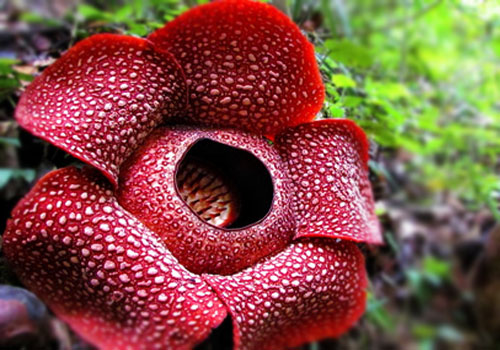The Rafflesia arnoldii.
The flower with the world's largest bloom is the Rafflesia arnoldii. This rare flower is found in the rainforests of Indonesia. It can grow to be 3 feet across and weigh up to 15 pounds! It is a parasitic plant, with no visible leaves, roots, or stem. It attaches itself to a host plant to obtain water and nutrients. When in bloom, the Rafflesia emits a repulsive odor, similar to that of rotting meat. This odor attracts insects that pollinate the plant.Another enormous flower found in Indonesia is the Amorphophallus titanum, or Titan arum. It is also known as the "corpse flower" for its unpleasant odor. Like the Rafflesia, the Titan emits the smell of rotting flesh to attract pollinators. Technically, the Titan arum is not a single flower. It is a cluster of many tiny flowers, called an inflorescence. The Titan arum has the largest unbranched inflorescence of all flowering plants. The plant can reach heights of 7 to 12 feet and weigh as much as 170 pounds!

The world's largest flower is found in many areas in Bengkulu forests, on the slopes of Bukit Barisan Mountains. The flower has a diameter of about one meter in full bloom. It has no visible root or stem, and no leaves. The weigth up to 7 kg, it takes the buds up to 8 months to mature. The flower stays in bloom from 1-15 days and can be seen during the months of September-December. Rafflesia Arnoldi is a big Flower in the worlds, if one visit Rejang Lebong, the Flower was stand at the City Center of CURUP as a monument, that is why, the people call Bengkulu is A LAND OF RAFFLESIA, or in Indonesian means BUMI RAFFLESIA, because in a certain seasons, if we are lucky, we can see a beautiful flower of Rafflesia, in the forest, which appear in periodic of 5 years or more.
Origin and distribution
Raffles and Arnold were touring the west coast of Sumatra in Borneo around the Manna river when their guide, excited and surprised, came to them with the news of having seen a very huge flower. The gigantic flower was named Rafflesia arnoldi by Raffles to commemorate his friendship with Arnold. Rafflesia sightings were reported much earlier though. Louis Auguste Deschamp, a French surgeon-naturalist, reported having seen the Rafflesia in 1797 in Java. Prior to both discoveries, the aborigines who had known about its presence were using Rafflesia for medicinal purposes. Since 1821, 24 Rafflesia species names have been published though not all of them are taxonomically resolved and identified.
Rafflesia is found in tropical rainforests of Malaysia, Singapore, Indonesia and Philippines. It occurs only in certain habitats as a parasite on the Tetrastigma species of woody vines. Rafflesia is a very rare flower, difficult to reproduce in the lab and its dried specimen is difficult to preserve. Other species of Rafflesia can measure between 36 to 42 in. in diameter and weigh between 9 to 12 kg.
Description
The first description of Rafflesia arnoldi was given by Robert Brown. Taxonomic classification of plant family Rafflesiaceae has not been thoroughly decided as yet. At least 55 species in eight genera however have been identified. The genera of Rafflesiaceae plant family are Apodanthes, Bdallophyton, Cytinus, Mitrastemon, Pilostyles, Rafflesia, Rhizanthes and Sapria. Since all the plants of this family are parasitic, they therefore do not have any roots, stems or leaves. Individual flowers or buds simply sprout on the species of Tetrastigma woody vines. They lack chlorophyll. Some flowers are monoecius, with both sexes in the same flower. All flowers of the family Rafflesiaceae may not carry the same parts and traits.
Usage and potential
Food: In Thailand, young buds of the flower are eaten as a delicacy.
Medicine: In Peninsular Malaysia, Rafflesia buds are used by women to stop internal bleeding and shrink the womb after childbirth. Men use it as an energy drink or an aphrodisiac. Thai monks use the buds to make different concoctions for different purposes. In spite of its usage for various purposes, the chemical composition of Rafflesia flowers has not been extensively analysed yet. Preliminary phytochemical screening, however showed no evidence of the flowers' medicinal properties. On the contrary, the buds and flowers have a high content of tannin and phenols which can be toxic when taken in large quantities.
Other uses: In Sabah, Malaysia, it was considered a flower of spirits or a taboo flower because of its foul smell and gigantic appearance. In Thailand, the flowers are believed to have mystical powers helping one attain nirvana.
Variant names
Common name: Rafflesia.
Scientific name: Rafflesia arnoldi.
Malay name: Bunga patma, Yak-yak, Patma raksasa, Patma kemubut, Krubut, Pakma (Sarawak), Kukuanga (Sabah), Wusak-tombuakar (Tambunan), Ambun ambun, Kemubut (Sumatra).
Mandarin name: Da wang hua.
Other common names: Devil's betel box, Sun toadstool, Stinking corpse lily.
Species of Rafflesia
The recognised species of Rafflesia with their scientific name, year and place of discovery are listed as follows:
1821: Rafflesia arnoldi, found at Sumatra, Borneo.
1825: Rafflesia patma, Sumatra, Java.
1841: Rafflesia manillana, Leyte Island, Phillipines.
1850: Rafflesia rochussenii, Sumatra, Java.
1868: Rafflesia tuan-mudae, Borneo.
1879:Rafflesia hasseltii, Sumatra.
1884: Rafflesia schadenbergiana, Mindanao, Philippines
1910:Rafflesia cantleyi, Peninsular Malaysia
1918: Rafflesia borneensis, Borneo.
1918: Rafflesia ciliata, Borneo.
1918: Rafflesia witkampii, Borneo.
1984: Rafflesia gadutensis, Sumatra.
1984: Rafflesia keithii, Borneo.
1984: Rafflesia kerrii, Thailand and Peninsular Malaysia.
1984: Rafflesia micropylora, Sumatra.
1984: Rafflesia pricei, Borneo.
1989: Rafflesia tengku-adlinii, Borneo.
 :a
:a
 :b
:b
 :c
:c
 :d
:d
 :e
:e
 :f
:f
 :g
:g
 :h
:h
 :i
:i
 :j
:j
 :k
:k
 :l
:l
 :m
:m
 :n
:n
 :o
:o
 :p
:p
 :q
:q
 :r
:r
 :s
:s
 :t
:t
No comments:
Post a Comment